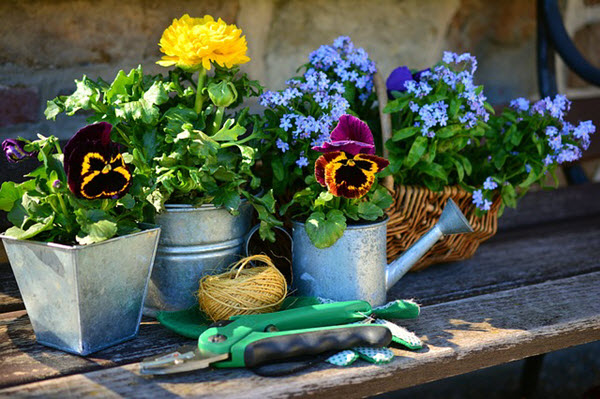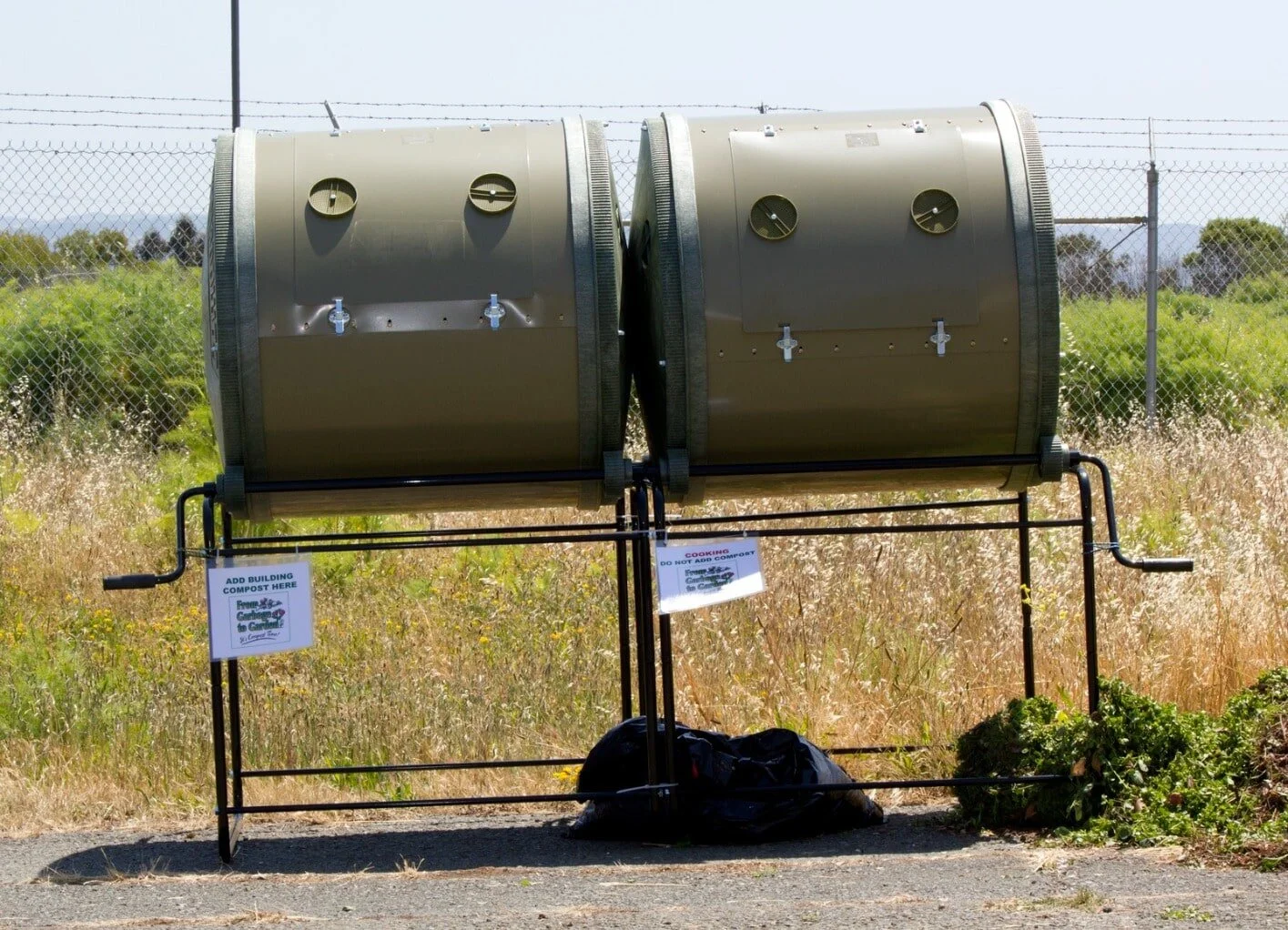Table of Contents
Just as with traditional gardens, container gardening has its seasonal tasks as well as seasonal planting.
Know what to expect with year-round container gardening - through Spring, Summer, Fall, and Winter.
This article was written in July, so let's start there.
Autumn
Yard Work
Right now, it's coming into Autumn/Fall here in the UK. On the East coast where I live, that means regular “squalls”.
(In case you don't have them where you live, they're low-level storms. While not even close to life threatening, they can do a lot of damage to container gardens as well as fences and trees. They're usually the tail-end of more serious storms over America - in the UK they are inconvenient more than anything. There are sharp and biting winds even on days with bright, clear skies that look as though they should be warm.)
Since my house is only about half a mile from the sea itself with very little between the coast and me, that wind will be salt-edged. Fortunately, I don't have any delicate plants. They usually aren't capable of surviving the exposed setting of my yard at the best of times so there's no need to worry about them.
The first thing I do at this time of year is move any hanging containers off of fence boards. It doesn't take much for a strong squall to bring a fence down, and the less weight on the boards, the better.
I move everything down to ground level. If it's lightweight, I make sure it's tied down. If it's heavy, I leave it alone if I know it has a reasonable chance of remaining upright through a squall. Other pots, I move from the fence boards to the back gate as the latter is much sturdier.
Small containers are moved to sheltered corners. Small and big pebbles, usually ones I've collected from the beach, are added to lightweight containers to give them a better chance of remaining upright.
Plant Care
In terms of actual plant care, my pepper plants have entered their dormancy. Their leaves have folded inwards and dried. This means it's time to harvest the last of the fruit and bring the plants themselves indoors. They should cope with the Winter just fine on the kitchen windowsill.
During this time, they'll only need watering a couple of times a month as they're not doing very much at all. I'll also take the opportunity to prune the bell pepper plant back a little to help stimulate new growth in the late Spring.
I grow rosemary and thyme because they're the main herbs I use when cooking. They'll be going dormant soon. The thyme is already shutting down and the rosemary is still just about with us and will be for another week or two. Occupying my windowsill, they will just need to be watered once or twice a month until Spring when they'll emerge from dormancy.
It's important to be aware that most plants don't “die”. They simply go dormant once their season is over. Dormancy can be distinguished from death very easily. When a plant goes dormant, all of its foliage “turns” at once. This means the leaves becoming brown and brittle, and folding in on itself.
When a plant is dying, leaves start to fade and fail one or two at a time. A dying plant also won't bear fruit, or flower, while one entering dormancy may well still have viable fruit. It is important that this fruit be harvested promptly before it goes further into its dormancy period.
Planting
Autumn is the time for planting broad beans. They'll be ready for harvesting in late Spring. Alongside planting these in the next couple of weeks, I'll be looking for suitable containers to plant carrots and parsnips. I'll initially plant both as seedlings indoors around November time, transplant outdoors in February, and then get ready for a mid Spring first crop.
I've already planted bulbs of early Spring flowers: daffodils, narcissi, snowdrops, and crocuses. In the next week or so, I'll be setting up hanging baskets of black and white pansies and tulips. These will provide a striking contrast to the softer, brighter Spring colours that will be blooming in ground-level containers.
Winter
Yard Tasks
Winter is the season for maintenance, boundary-fence checks, and hardscaping.
With the majority of plants in dormancy, the yard is more or less a blank canvas for me. I'll be looking into what additional hardscaping elements would work, what needs to be painted, and what could do with being moved around.
I have a small garden bench designed to look like a horse. This will need to be brought inside and painted over the Winter, given another coat of varnish, and put outside in late January. I wait till late January because that's when the worst of the rain and wind would have passed by.
Containers will need to be checked for cracks caused by frost, or falls during high winds. Also, chains on hanging baskets and nails holding containers onto the back gate will need to be checked for rust. The bolts and hinges on the gate will need to be oiled, and the gate and fence will need to be given their annual coat of varnish.
Planting
Winter is the time of conifers and holly bushes, ivy and a few bright, hardy perennials like pyracantha which will add a welcome jauntiness to the grey days.
Spring
Yard Tasks
Nothing much will need doing to the yard other than picking up on any damage caused by particularly bad Winter weather.
Plants
Spring brings the bright and soft colours of tulips, daffodils, narcissi, crocuses, and snowdrops, as well as the more striking hues of black tulips and pansies. I'll be setting up these tulips and pansies in hanging baskets in early Autumn in time for a Spring flowering.
Spring vegetables include parsnips, carrots, and broad beans. Herbs and other plants also begin to come out of their Winter dormancy around this time. Home-sourced salads are firmly back on the menu. A personal favourite of mine is parsnip chips dusted with rosemary. I serve them alongside a salad of grated carrot, chopped apple, broad beans and chick peas. Yummm!
Both my chilli and bell pepper plants should also be coming out of dormancy so salads may even get to be accessorised with a salsa dip or sliced sweet pepper.
Planting
Spring is the time to plant your summer fruit and vegetables. This year, I'll be looking for ground-level containers large enough to host lettuces and cucumbers, as well as my usual tomatoes and strawberries. I grow those indoors as the seagulls like to get those before I do.
Summer
Yard Tasks
I have a pond hosted in half a whisky barrel. Summer means adding a couple of fresh oxygenating plants and making sure the water level is topped up.
There's no fish in the pond, but late Spring will see the arrival of several small water-based varieties of insect life. They'll set up a happy home through the Summer and provide a plentiful source of food for passing birds.
Summer is also the time to pay attention to what manufactured hardscaping elements don't cope too well with strong sunlight. These will either need to be replaced come Autumn or Winter, or retired altogether if they weather particularly badly.
Plants
Summer is party season as far as plants go, with the soft colours of Spring giving way to Summer's bolder hues. I have rose bushes, both crimson and white, which will provide the bulk of my garden's summer colour.
Tomatoes, lettuce, cucumber and strawberries will all be fruiting. The reds of the fruits will contrast well with the greens of the vegetables and tasting even better together on a plate!
My herbs and peppers will be at full strength from May through to September. The herbs will be giving off a subtle scent in the kitchen while the peppers will be boosting the overall balmy brightness of the yard.
Planting
I'll be planting Winter vegetables throughout the summer. This is actually the first time I'll be doing this and I'll be focusing on broccoli and cauliflower.
Rather than growing for selling, I am planting for myself and the culinary tastes of my household. Once harvested, the cauliflower will be taken in, beaten to a pulp, and blended with cheesy mashed potato with mushrooms added in. It's delicious, I tell you.
I'll also be researching whether it would be possible for me to successfully grow potatoes, mushrooms, and other plants I'm interested in given that my "garden" is literally just a concrete yard.
Stay posted! I hope sharing my activities throughout the year has given you an idea of what to expect as the seasons roll in.














